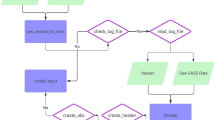Abstract
ISRO’s Imaging InfraRed Spectrometer (IIRS) onboard Chandrayaan-2 is relatively the most advanced spectrometer in the lunar orbit till date. IIRS operates from 0.8 to 5µm spectral range and has been sampling the lunar surface in 250 spectral channels with 20 nm spectral and 80 m spatial resolution. The data are transmitted in strips of hyper-spectral cubes. These datasets do not have spatial information embedded in them. Spatial information is provided as a separate geometry file containing line/sample wise lat/long information. In order to impart spatial information to cubes, multiple steps are involved requiring manual intervention. This approach is time consuming as well as prone to error. Since most tools available are proprietary, it is not possible to acquire and understand the source code and supplement it to run on multiple datasets automatically. In order to overcome these challenges SelenoRef, a python-based tool has been developed to automate the process of Seleno-referencing of Ch-2 IIRS hyper-spectral cubes. SelenoRef requires three inputs viz. input folder containing downloaded zipped files, output folder for processed data and desired projection system. SelenoRef autonomously unzips all datasets from the input folder and navigates through the directory structure to locate hyper-spectral cubes, geometry information file and metadata file to retrieve the dataset, lat/long information and projection, respectively. Cubes are seleno-referenced using Ground Control Points (GCPs), band statistics are calculated and output is generated in the output directory. SelenoRef is open source and has a graphical user interface.





Similar content being viewed by others
References
Beautiful Soup Documentation. (2023). https://www.crummy.com/software/BeautifulSoup/bs4/doc/
Chauhan, P., Chauhan, M., Verma, P. A., Sharma, S., Bhattacharya, S., Dagar, A. K., Patil, A. N., Parashar, A. K., Kumar, A., Desai, N., & Karidhal, R. (2021). Unambiguous detection of OH and H2O on the Moon from Chandrayaan-2 imaging infrared spectrometer reflectance data using 3 μm hydration feature. Current Science, 121(3), 391–401. https://doi.org/10.18520/cs/v121/i3/391-401
Chowdhury, A. R., Banerjee, A., Joshi, S. R., Dutta, M., Kumar, A., Bhattacharya, S., Amitabh, R., Bhati, S. U., Karelia, S., Biswas, J. C., Saxena, A., Sharma, A. R., Somani, S., Bhagat, S. R., Sharma, H. V., Ghonia, J., Bokarwadia, D. N., Parasar, B. B., & Parasar, A. (2020). Imaging infrared spectrometer onboard Chandrayaan-2 Orbiter. Current Science, 118(3), 368–375. https://doi.org/10.18520/cs/v118/i3/368-375
Glob Documentation. (2023, December 1). https://docs.python.org/3/library/glob.html
GeoPandas. (2022). https://geopandas.org/en/stable/
Li, S., Lucey, P. G., Milliken, R. E., Hayne, P. O., Fisher, E., Williams, J. P., Hurley, D. M., & Elphic, R. C. (2018). Direct evidence of surface exposed water ice in the lunar polar regions. Proceedings of the National Academy of Sciences of the United States of America. https://doi.org/10.1073/pnas.1802345115
lxml - Processing XML and HTML with Python. (2022, December 13). https://lxml.de/
Moon icon - Free Flat Icons Vol 2 | Free icons. (2019, June 22). https://icons-for-free.com/Moon-1320568043578978300/
Negi, S. M., & Vaibhav, G. (2020). ISRO’s unprecedented Journey to the Moon. Acta Astronautica, 177(August), 286–298. https://doi.org/10.1016/j.actaastro.2020.07.046
OSGeo - The Open Source Geospatial Foundation. (2023). https://www.osgeo.org/
pandas - Python Data Analysis Library. (2023). https://pandas.pydata.org/
PDS Geosciences Node. (2015). Lunar Orbital Data Explorer (LODE). https://ode.rsl.wustl.edu/moon/
Pieters, C. M., Boardman, J., Buratti, B., Chatterjee, A., Clark, R., Glavich, T., Green, R., Head, J., Isaacson, P., Malaret, E., McCord, T., Mustard, J., Petro, N., Runyon, C., Staid, M., Sunshine, J., Taylor, L., Tompkins, S., Varanasi, P., & White, M. (2009a). The moon mineralogy mapper (M3) on Chandrayaan-1. Current Science, 96(4), 500–505.
Pieters, C. M., Goswami, J. N., Clark, R. N., Annadurai, M., Boardman, J., Buratti, B., Combe, J. P., Dyar, M. D., Green, R., Head, J. W., Hibbitts, C., Hicks, M., Isaacson, P., Klima, R., Kramer, G., Kumar, S., Livo, E., Lundeen, S., Malaret, E., & Varanasi, P. (2009). Character and spatial distribution of OH/H2O on the surface of the moon seen by M3 on chandrayaan-1. Science, 326(5952), 568–572. https://doi.org/10.1126/science.1178658
Pyspatial. (2016). https://pyspatial.readthedocs.io/en/latest/
Python Software Foundation. (2016). Welcome to Python.org. https://www.python.org/
Python Software Foundation. (2021). tkinter — Python interface to Tcl/Tk. Python Software Foundation. https://docs.python.org/3/library/tkinter.html
Rasterio: Access to geospatial raster data. (2018). https://rasterio.readthedocs.io/en/stable/
Spatial Reference. (2013). https://spatialreference.org/ref/?search=moon
Roseman, M. (2020). Modern Tkinter for busy Python developers : Quickly learn to create great looking user interfaces for Windows. Late Afternoon Press.
Shapely documentation. (2023). https://shapely.readthedocs.io/en/stable/manual.html
Shutil - High-level file operations. (2023). https://docs.python.org/3/library/shutil.html
Verma, P. A., Chauhan, M., & Chauhan, P. (2022). Lunar surface temperature estimation and thermal emission correction using Chandrayaan-2 imaging infrared spectrometer data for H2O & OH detection using 3 μm hydration feature. Icarus, 383, 115075. https://doi.org/10.1016/J.ICARUS.2022.115075
Warmerdam, F., & Rouault, E. (2023). GDAL — GDAL documentation. https://gdal.org/
XML Core Working Group Public Page. (1997). https://www.w3.org/XML/Core/#Publications
Zipfile Documentation. (2023). Python Software Foundation. https://docs.python.org/3/library/zipfile.html
Funding
Department of Science and Technology, Government of India, IF200115, Ishan Rayal
Author information
Authors and Affiliations
Corresponding author
Additional information
Publisher's Note
Springer Nature remains neutral with regard to jurisdictional claims in published maps and institutional affiliations.
Supplementary Information
Below is the link to the electronic supplementary material.
About this article
Cite this article
Rayal, I., Chauhan, P., Thakur, P.K. et al. Python-Based Open-Source Tool for Automating Seleno-Referencing of Chandrayaan-2 Hyper-Spectral Data Cubes. J Indian Soc Remote Sens 52, 305–313 (2024). https://doi.org/10.1007/s12524-024-01814-4
Received:
Accepted:
Published:
Issue Date:
DOI: https://doi.org/10.1007/s12524-024-01814-4




